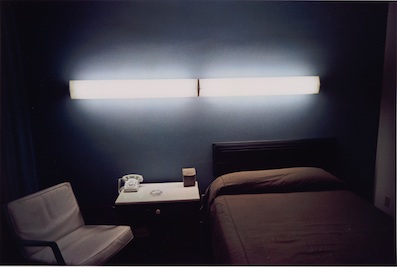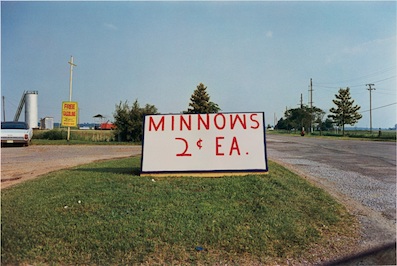
The first color photograph William Eggleston ever took depicts a young man – a clerk at a Memphis, Tennessee supermarket – pushing a chain of shopping carts. He wears a crisp white shirt and long apron and is bathed in the golden light of late afternoon. In the background, a woman in sunglasses, a black handbag held on her wrist, makes her way from the parking lot toward the entrance to the market.
The vivid, saturated color and painterly composition transform the seemingly mundane scene in the image, Untitled, Memphis, 1965, into a work that captures the imagination of the viewer, causing us to pause, really look and consider, free to draw our own conclusions.

It is the work of a master, now widely recognized as the “pioneer of modern color photography.”
The image is one of 75 photographs, shown for the first time in their entirety in New York, in the exhibition, William Eggleston: Los Alamos at The Metropolitan Museum of Art in New York City from February 14 – May 18th.
The series of photographs, shot in Memphis, the Mississippi delta region and on road trips across the American south and southwest in between 1965 and 1974, together tell the story of a distinctly American landscape, at once familiar and foreign in that we are forced to fill in the blanks, inferring whole scenes from carefully observed details; a soda left on the hood of a car, a woman’s hand stirring a drink in a pool of sunlight on an airplane, a stark Las Vegas hotel room, a hand-lettered sign advertising “Flavors” (Strawberry, Blueberry, Chocolate, Nectar. . . ).
In a preview of the exhibition held on Tuesday morning, Jeff L. Rosenheim, the Joyce Frank Menschel Curator in Charge in the Department of Photographs, told the assembled crowd of the images, “These subjects are not themselves that significant or symbolic. They become symbolic when the artist anoints them with his intention. I believe. . . that seeing is a creative act and that our best artists show us not what to see, but how to see; how to capture, from the ever changing experience of the world, those poignant moments, the color of light, those spaces that the artist himself is drawn to.”

With their warm, vivid colors and golden-hued beams of light, a modern viewer may regard the images with a certain nostalgia; however, at the time, Eggleston was documenting life as it was before him, both simple and complex, and always changing.
“Eggleston explicitly went out of his way to photograph those social facts of his time,” Rosenheim said. “The transformation, in the 1950s of American space, is something that the best artists of the day. . . all explored; Eggleston in color.”

Spread over three galleries in the museum, the images are accompanied only by labels and assorted quotes from Eggleston. In one, he says, “Often people ask me what I am photographing. It’s a hard question to answer. And the best I have come up with is I just say ‘life today.’ I don’t know if they believe me or not. Or what that means.”

All 75 prints were made in 2002 from color negatives using dye-transfer printing. Eggleston was one of the first artists to take dye-transfer from the commercial world, where it was often used in printing signs and advertisement, into the realm of fine art. In another quote included in the exhibition, Eggleston said, “I don’t think anything has the seductivity of [dye-transfer prints]. . . .By the time you get into all those dyes, it doesn’t look at all like the scene. . .which, in some cases, is what you want.”

William Eggleston is a master of his craft, expertly wielding color and composition to compose a running narrative told through glimpses and fragments of American life. The 75 images that make up Los Alamos prove a seductive entry to the story.
What: William Eggleston: Los Alamos
Where: The Metropolitan Museum of Art, New York City
When: February 14 – May 18, 2018
Don’t Miss: The exhibition includes a small collection of Eggleston’s rarely shown black and white photos taken in the late 1960s and 1970s, at the same time he was working on Los Alamos.
Photos: Courtesy of the Metropolitan Museum of Art, New York
For information about other exhibitions visit the metmuseum website


Be the first to comment